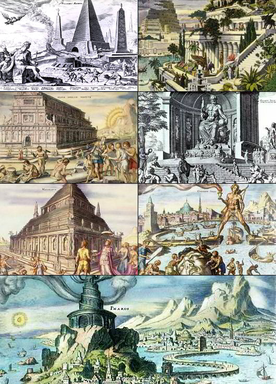
Back Sewe wonders van die wêreld Afrikaans Weltwunder ALS عجائب الدنيا Arabic عجايب الدنيا السبعه ARZ Dünyanın möcüzələri Azerbaijani Седемте чудеса на модерния свят Bulgarian পৃথিবীর বিস্ময় Bengali/Bangla Divy světa Czech Weltwunder German Θαύματα του κόσμου Greek


Various lists of the Wonders of the World have been compiled from antiquity to the present day, in order to catalogue the world's most spectacular natural features and human-built structures.
The Seven Wonders of the Ancient World is the oldest known list of this type, documenting the most remarkable human-made creations of classical antiquity; it was based on guidebooks popular among Hellenic sightseers and as such only includes works located around the Mediterranean rim and in the ancient Near East. The number seven was chosen because the Greeks believed it represented perfection and plenty, and because it reflected the number of planets known in ancient times (five) plus the Sun and Moon.[1]
- ^ Anon. (1993). The Oxford Illustrated Encyclopedia (First ed.). Oxford: Oxford University.
© MMXXIII Rich X Search. We shall prevail. All rights reserved. Rich X Search